As an Amazon Associate KitchenwareSets.com earns from qualifying purchases.
11 Easy Kitchen Table Makeover Ideas That Look Professional
Feeling like your kitchen table has seen better days? That single piece of furniture, the heart of your kitchen, can make the entire room feel dated, worn, or just plain uninspired. It’s where homework gets done, meals are shared, and conversations happen, but when its style doesn’t match the rest of your home, it sticks out for all the wrong reasons.
We’ve all been there—staring at a perfectly functional but dated piece of furniture, wishing it could be replaced. You might think your only option is to spend hundreds, if not thousands, on a brand-new table. But what if you could achieve a stunning, professional-looking transformation for a fraction of the cost, all with a little bit of weekend effort?
A kitchen table makeover is a cost-effective DIY project that transforms an old or worn-out table into a stylish centerpiece. Using techniques like painting, staining, or refinishing, you can update your dining space for under $120, a fraction of the cost of buying new. This guide is built from real-world projects and lessons learned to help you achieve a professional look without the professional price tag.
Feeling Uninspired by Your Old Kitchen Table?
That old kitchen table, with its scuffs, scratches, and outdated finish, can bring down the whole aesthetic of your dining space. It’s the centerpiece of the room, yet it might feel more like an eyesore than a focal point. Replacing it seems expensive and wasteful, especially if it’s still structurally sound. This is where the magic of a DIY makeover comes in. A kitchen table makeover is the perfect, budget-friendly solution to completely transform your space, upcycle a quality piece of furniture, and create something that perfectly reflects your personal style.
Why a Kitchen Table Makeover is Your Best Weekend Project
A DIY table makeover is one of the most rewarding home projects because it delivers a huge visual impact for a minimal investment of time and money. Instead of settling for a generic new table, you get to create a custom piece that’s unique to your home.
- Significant Cost Savings: A full DIY dining table makeover typically costs between $20 and $120 for materials. Compare that to professional refinishing, which can cost upwards of $400, or buying a new table, which can easily be even more.
- Creative Freedom: You are in complete control of the final look. Whether you prefer a modern farmhouse aesthetic, a sleek industrial vibe, or a pop of vibrant color, you can tailor the finish to your exact taste.
- Eco-Friendly Choice: Upcycling furniture is a fantastic way to be sustainable. By restoring and repurposing your existing table, you’re saving a perfectly good piece of furniture from the landfill.
- Sense of Accomplishment: There’s nothing quite like the satisfaction of transforming something old into something beautiful with your own two hands. Your made-over table will be a conversation starter you can be truly proud of.
11 Easy Kitchen Table Makeover Ideas That Look Professional
Ready to get inspired? Whether you have 30 minutes or a full weekend, there’s a makeover idea here for you. This curated list covers everything from quick updates to full refinishing projects, drawing from successful DIYs to ensure you get a result you’ll love. Each idea is designed to be achievable, even for beginners, and will leave you with a durable, professional-looking piece that revitalizes your entire kitchen.
1. Refresh With New Seating for an Instant Modern Lift
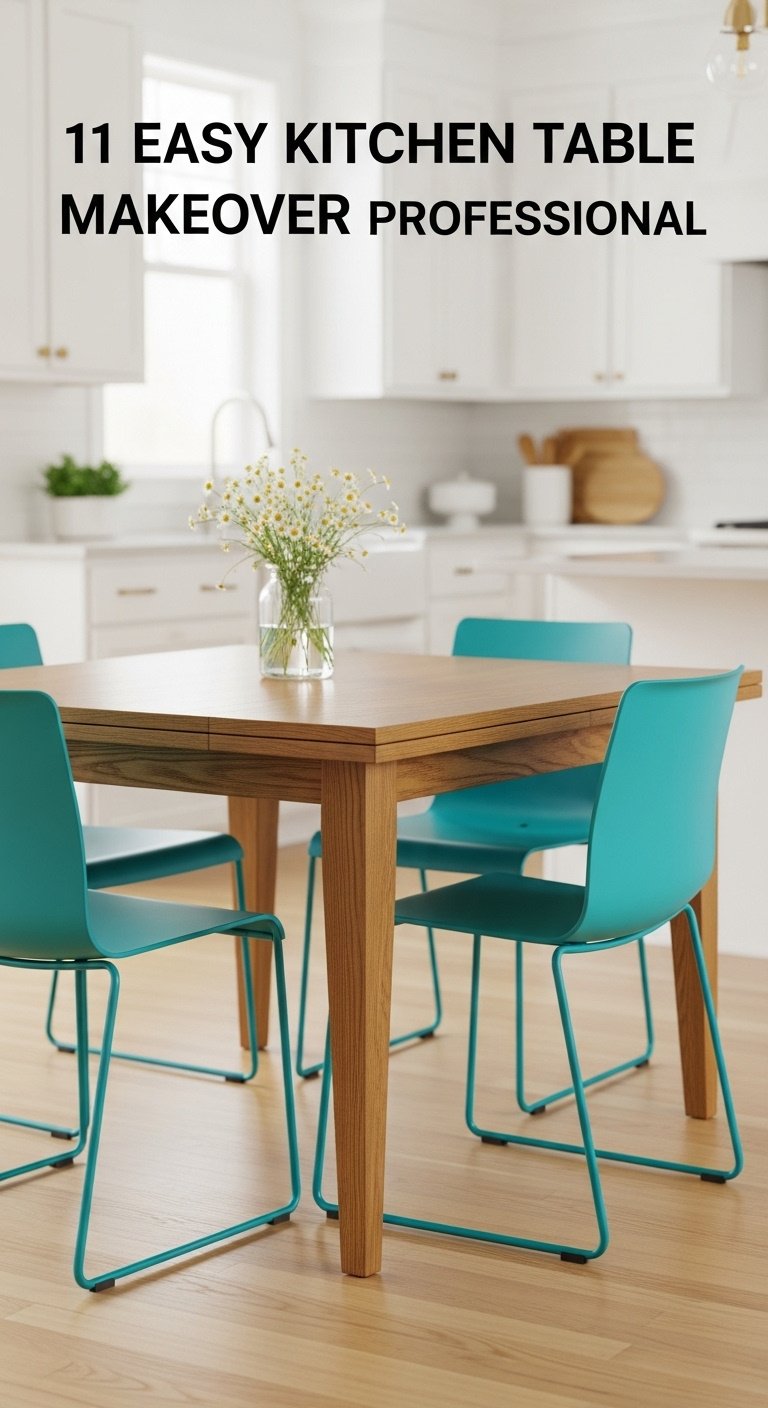
The simplest way to update your dining set is by changing the chairs without even touching the table itself. Swapping out old, matching chairs for a new style, color, or material can instantly modernize the entire look of your dining area.
- Materials Needed: New chairs or bench, or fabric/cushions/paint for existing chairs.
- Step-by-Step Directions:
- Assess Your Style: Decide if you want a contrasting look (e.g., metal chairs with a wood table) or a complementary one.
- Option A – Replace: Simply swap your old chairs for new ones or a stylish bench to create more visual space and a contemporary feel.
- Option B – Reupholster: Remove old seat cushions from your existing chairs, wrap them in a fresh, modern fabric, and secure it underneath with a staple gun.
- Option C – Repaint: Lightly sand and prime existing wooden chairs, then apply 2-3 coats of a vibrant new color to create a dramatic contrast with your tabletop.
Pro-Tip: For a cohesive look, pull a color from your new chair fabric or cushions and use it for a table runner or centerpiece.
Pin this easy update for your next weekend project!
2. Create a High-Gloss Finish with an Epoxy Resin Top
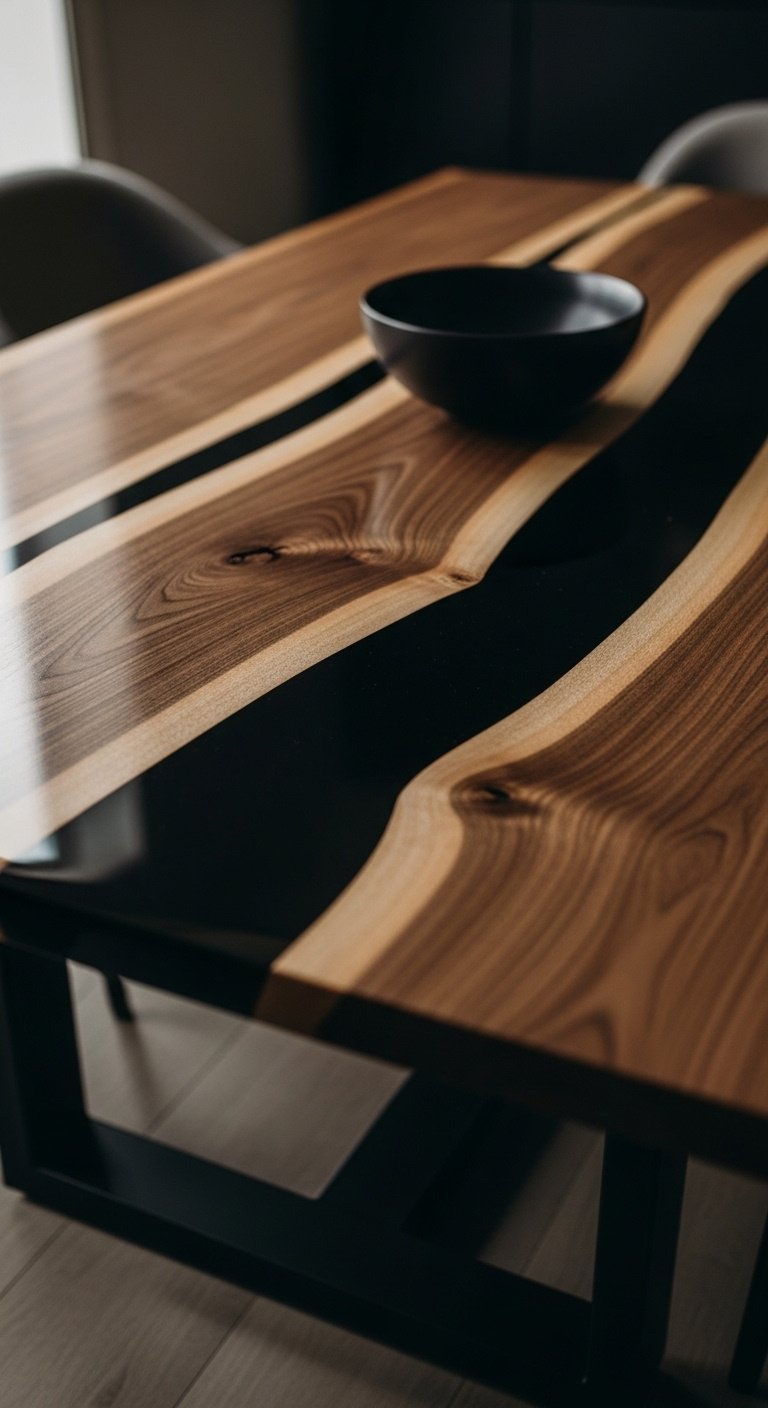
For a truly dramatic and modern transformation, cover your tabletop with epoxy resin for a durable, high-gloss, glass-like finish. Epoxy allows you to create unique designs, like river effects, or simply provide an ultra-durable clear coat over your existing wood.
- Materials Needed: Two-part epoxy resin kit, mixing buckets, stir sticks, heat gun or torch, level, painter’s tape to create a dam.
- Step-by-Step Directions:
- Prepare: Ensure your tabletop is clean, dry, and perfectly level. Tape off the edges to create a dam that will contain the epoxy and prevent drips.
- Mix: Carefully mix the resin and hardener according to the manufacturer’s instructions. This step is critical, so follow the directions precisely. Add pigment if desired.
- Pour: Pour the mixed epoxy evenly over the tabletop, starting in the center and working your way out.
- Spread & Pop Bubbles: Use a spreader to guide the epoxy to the edges. Gently use a heat gun or torch a few inches above the surface to pop any air bubbles that rise.
- Cure: Let the table cure undisturbed in a dust-free area for at least 72 hours before light use.
Lesson Learned: Always mix more epoxy than you think you’ll need. It’s better to have extra than to come up short mid-pour and create an uneven layer.
Save this dramatic table transformation to your DIY board!
3. Swap or Add a Sleek Glass Top
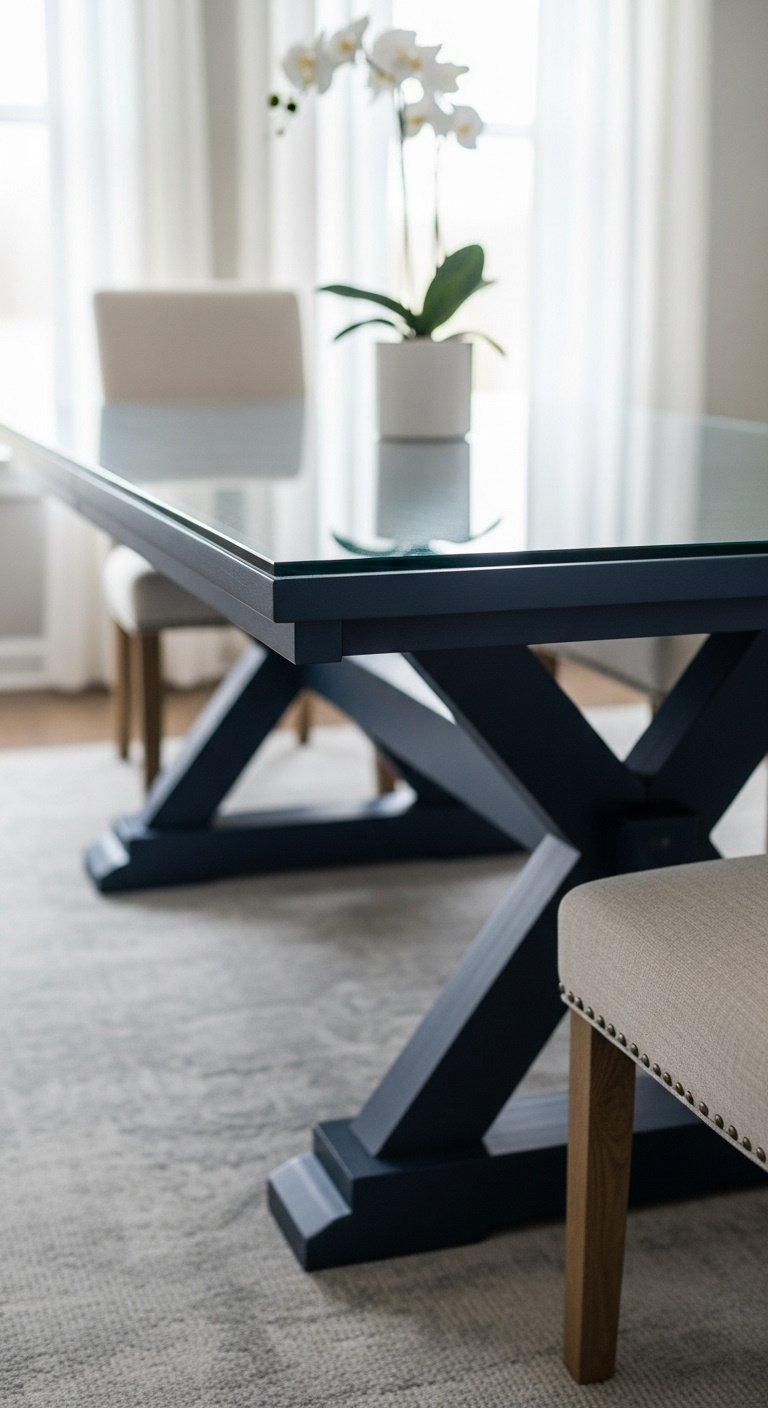
To add a layer of protection and a touch of modern elegance, place a custom-cut piece of tempered glass over your existing tabletop. This is an incredibly simple update that makes the surface easy to clean and gives the table a sleek, contemporary look.
- Materials Needed: Custom-cut glass top (approx. 0.5″ thick), clear rubber bumper pads.
- Step-by-Step Directions:
- Measure: Accurately measure the length and width of your tabletop. Decide if you want the glass to be flush with the edges or have a slight overhang.
- Order: Order a custom-cut piece of tempered glass from a local glass supplier or online. Specify the thickness and any edge finishing you’d like (e.g., beveled, polished).
- Clean: Thoroughly clean both the tabletop and the new glass top to remove any dust or fingerprints.
- Place: Put small, clear rubber bumper pads on the corners of your tabletop to prevent the glass from sliding. Carefully place the glass top onto the bumpers.
Pro-Tip: For an extra layer of style, place a beautiful wallpaper or a high-quality decal on your wooden tabletop before adding the glass top for a protected, custom design.
Love modern design? Pin this simple table upgrade!
4. Go Industrial with a New Metal Table Base
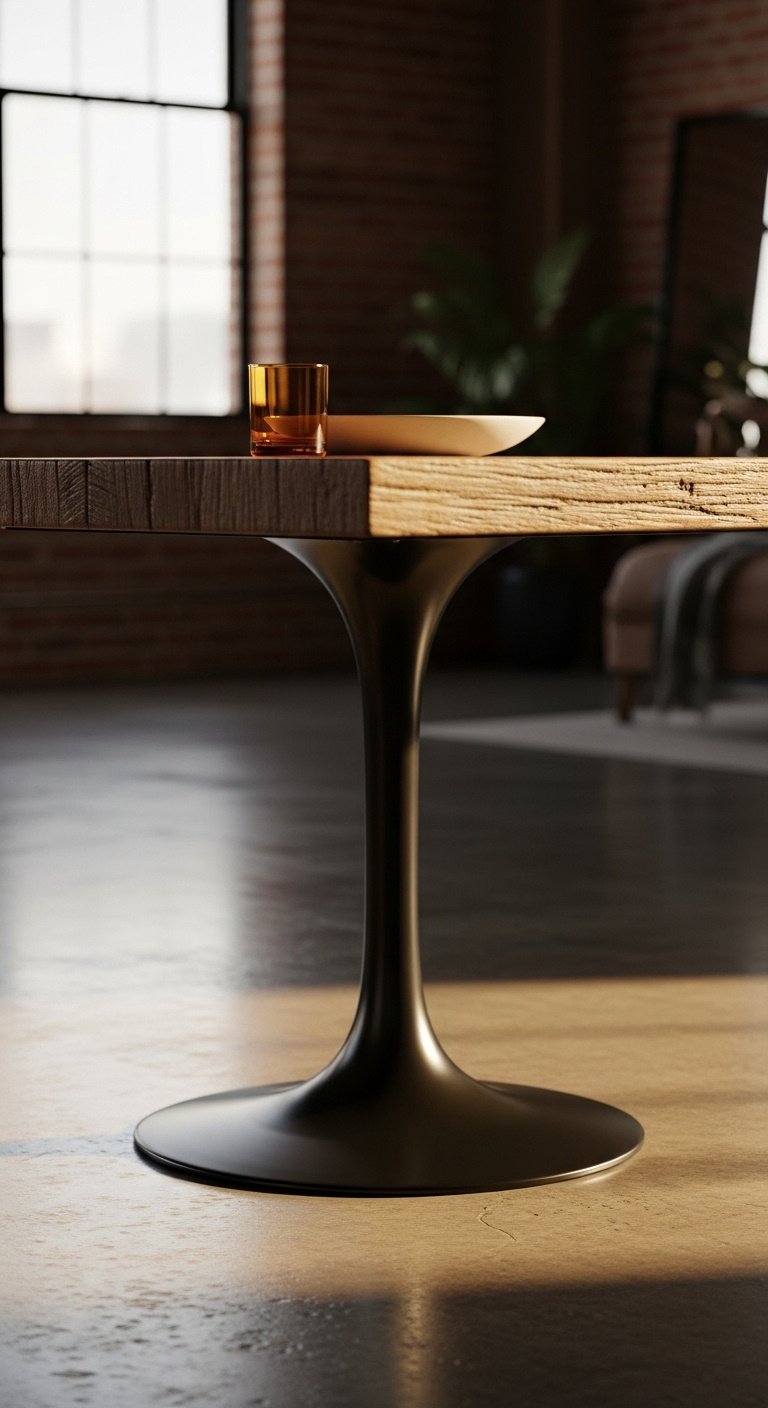
You can completely change your table’s personality by keeping the top and replacing the old wooden legs with a modern metal base. This creates a striking industrial or contemporary look, pairing the warmth of a wood top with the cool, clean lines of steel.
- Materials Needed: New metal table base, screwdriver or drill, appropriate screws for your tabletop.
- Step-by-Step Directions:
- Remove Top: Carefully flip your table over and unscrew the existing base or legs from the tabletop.
- Position New Base: Place the new metal base in the center of the upside-down tabletop. Use a measuring tape to ensure it’s perfectly centered.
- Mark Holes: Mark the screw hole locations on the tabletop with a pencil.
- Attach Base: Drill pilot holes if necessary, then securely attach the new base to the tabletop using the appropriate screws.
- Flip & Admire: Carefully flip your newly transformed table upright.
Pro-Tip: Before buying a base, check its weight capacity and recommended tabletop size to ensure it’s a stable and safe match for your existing top.
Pin this high-style DIY for a major table transformation!
5. Add Personality with Hand-Painted or Stenciled Patterns
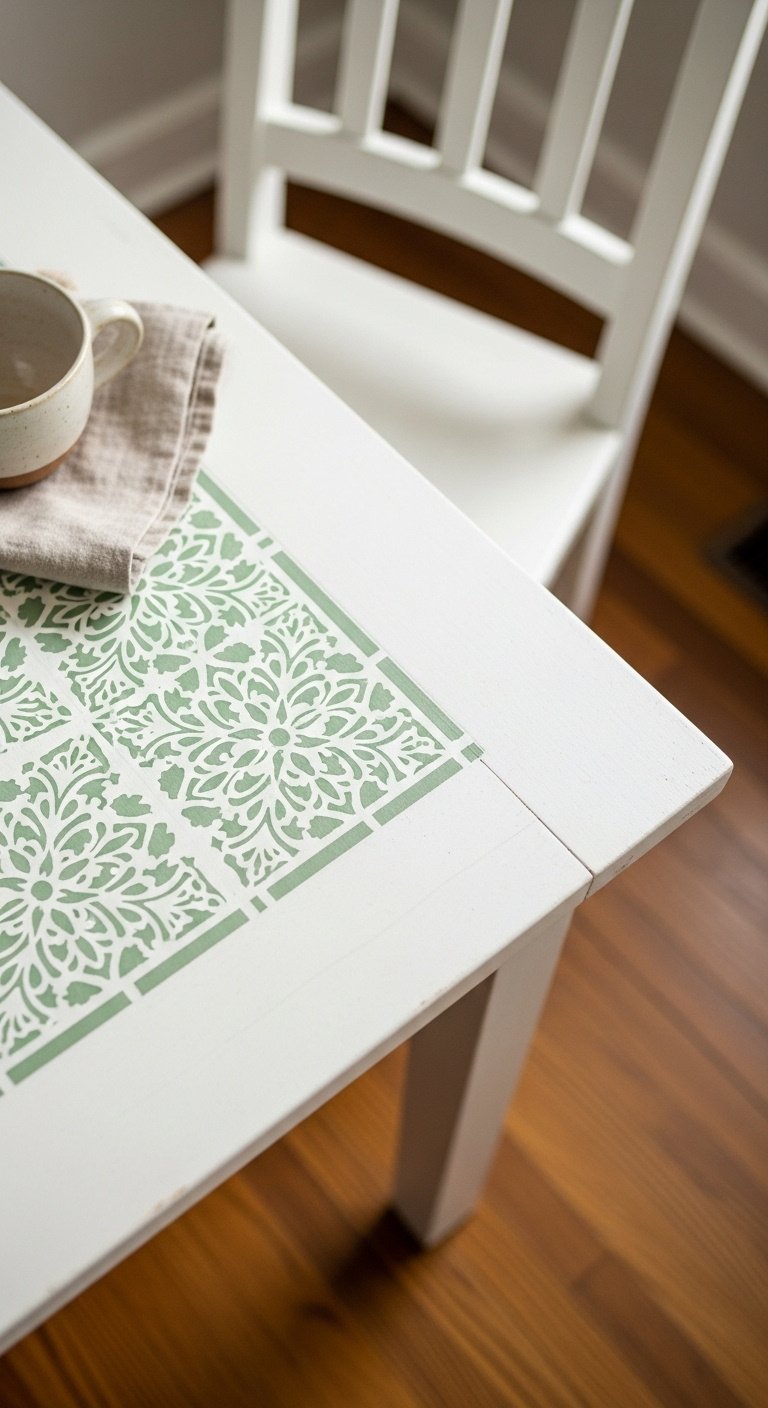
Turn your tabletop into a work of art by adding a custom design with paint, using either stencils or freehand techniques. This is a fantastic way to add a unique, personal touch, whether you prefer modern geometric patterns, classic stripes, or intricate floral designs.
- Materials Needed: Fine-grit sandpaper, base coat of paint, artist’s brushes or stencils, acrylic craft paint for the pattern, polyacrylic protective finish.
- Step-by-Step Directions:
- Prep the Surface: Lightly sand the tabletop and apply 1-2 coats of your chosen base color. Let it dry completely.
- Create the Pattern: Use painter’s tape to create geometric shapes or stripes. Alternatively, use a stencil and a foam pouncer to apply your design. For freehand designs, lightly sketch with a pencil first.
- Paint: Carefully paint your pattern using acrylic craft paints. Apply a second coat if needed for full coverage.
- Remove Tape: If using tape, remove it while the pattern paint is still slightly wet to achieve the crispest lines.
- Seal: Once everything is fully dry, apply 3-4 coats of a water-based polyacrylic finish to protect your artwork from daily wear and tear.
Lesson Learned: Always use a light touch when stenciling. It’s better to apply two thin coats to prevent paint from bleeding under the stencil edges.
Get creative! Save this painted table idea for inspiration.
6. Repaint the Table Legs for a Pop of Color
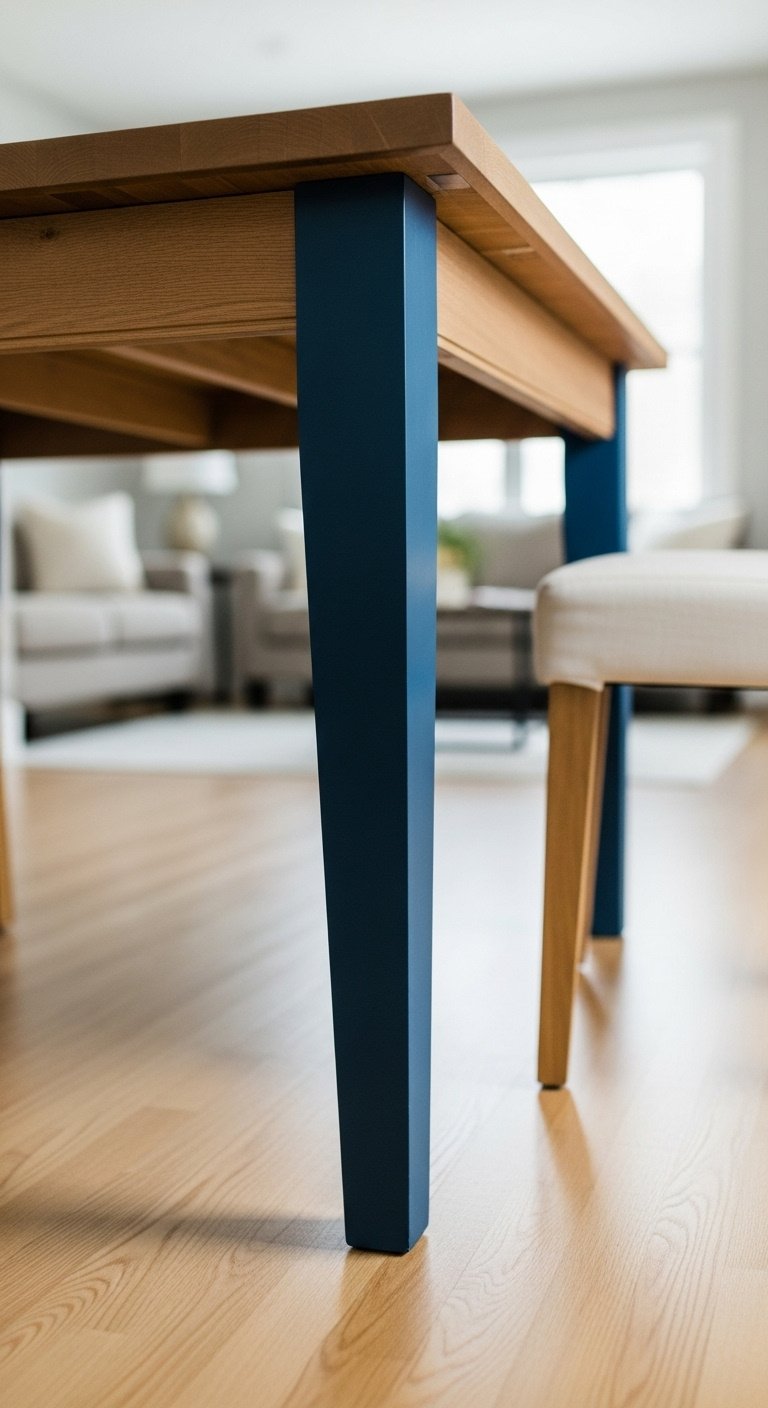
For a subtle yet high-impact update, leave the tabletop as is and paint only the table legs and apron. This creates a modern two-tone effect and allows you to introduce a playful pop of color—like a deep hague blue, a soft pastel green, or a classic black—without overwhelming the space.
- Materials Needed: Painter’s tape, drop cloth, fine-grit sandpaper, primer, paint of choice (e.g., chalk paint, semi-gloss).
- Step-by-Step Directions:
- Protect the Top: Carefully tape off the underside of the tabletop where it meets the apron and legs. Cover the tabletop completely with a drop cloth or paper.
- Prep the Legs: Lightly sand the legs to scuff up the existing finish, which helps the primer and paint adhere. Wipe clean with a tack cloth.
- Prime: Apply one coat of primer to ensure the paint adheres well and the color appears true.
- Paint: Apply 2-3 thin coats of your chosen color, allowing adequate drying time between each coat for a smooth finish.
- Remove Tape: Once the final coat is dry to the touch, carefully remove the painter’s tape. Let the paint cure fully before use.
Pro-Tip: For a super smooth, professional finish on turned or detailed legs, consider using spray paint. It gets into crevices more easily than a brush.
Add a splash of color! Pin this simple painting idea.
7. Apply an Impressive (and Removable) Decal
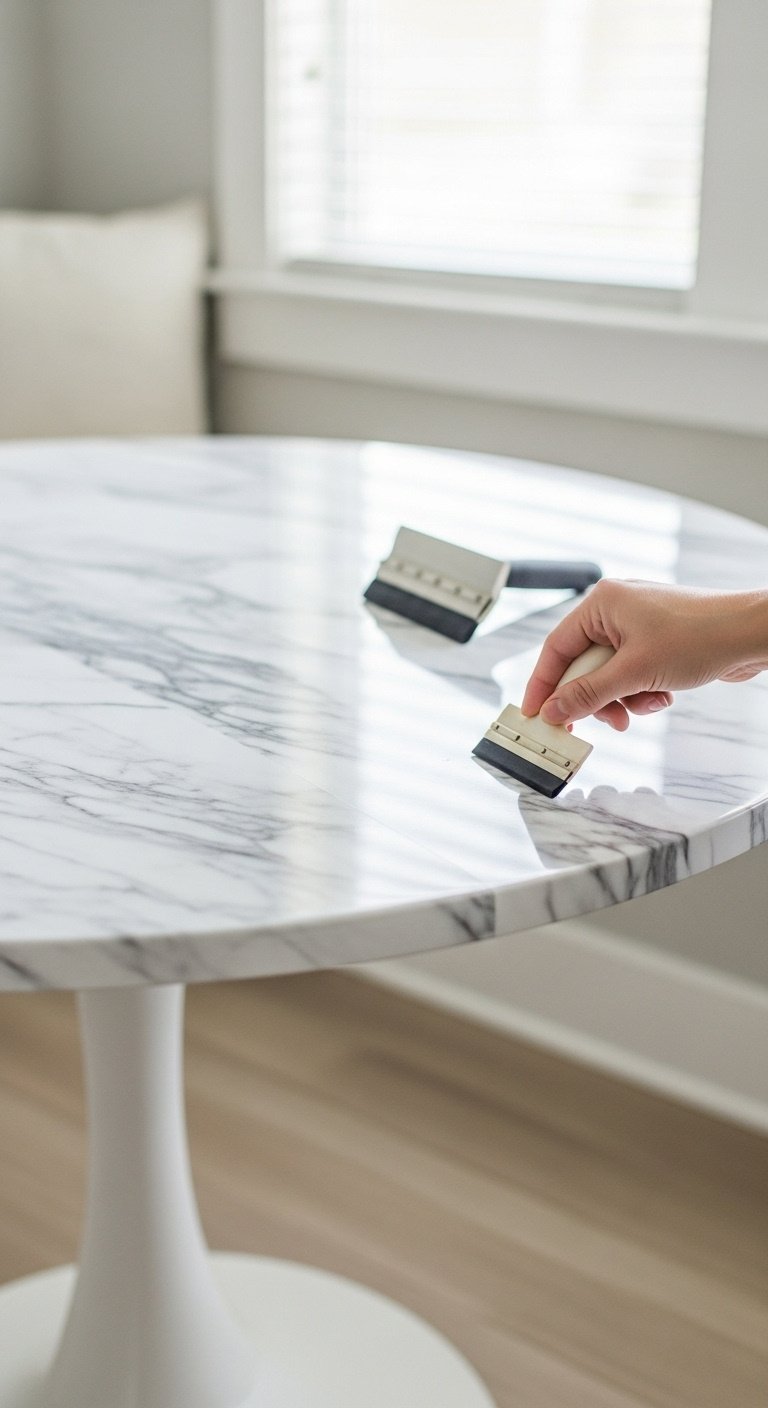
One of the fastest and most renter-friendly makeovers is to use a large, high-quality vinyl decal to cover the tabletop. With incredibly realistic options like marble, wood grain, or abstract patterns, you can get a brand-new look in under an hour with no mess and no permanent changes.
- Materials Needed: A large tabletop decal, measuring tape, squeegee or credit card, craft knife.
- Step-by-Step Directions:
- Clean Surface: Thoroughly clean and dry the tabletop. Any dust or grease will prevent the decal from adhering properly and can cause bubbles.
- Position: Carefully unroll the decal and position it on the table. Use painter’s tape to hold one edge in place to act as a hinge.
- Apply: Peel back a few inches of the backing paper from the taped edge. Using the squeegee, press the decal onto the table, working from the center out to push out air bubbles.
- Continue: Slowly continue peeling the backing paper while smoothing the decal with the squeegee until the entire surface is covered.
- Trim: Use a sharp craft knife to carefully trim any excess decal from the edges of the table for a perfect, seamless fit.
Pro-Tip: For large decals, lightly misting the table surface with water can make it easier to reposition the decal and squeegee out bubbles before it fully adheres.
Love a quick transformation? Pin this renter-friendly idea!
8. Decorate with Durable Wallpaper for Texture and Style
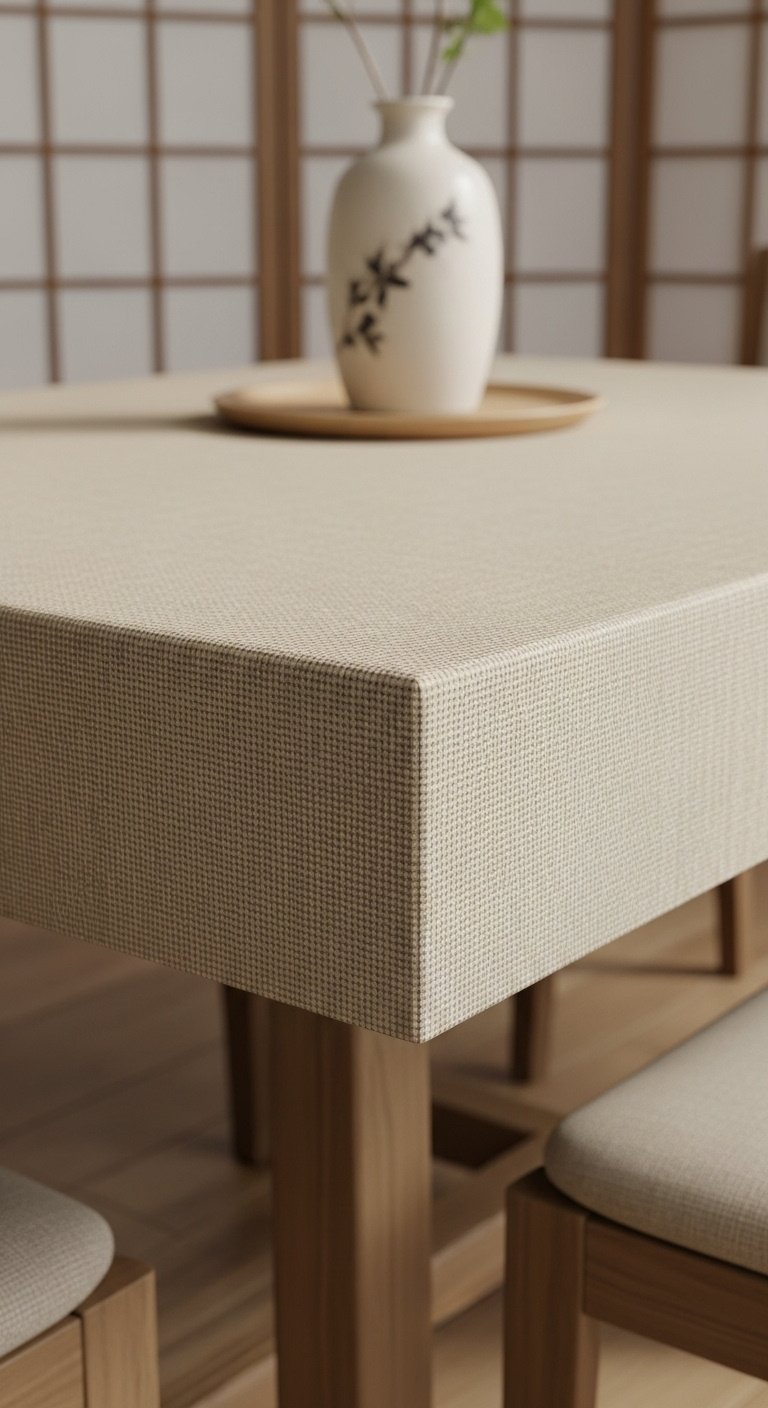
To conceal imperfections like cracks or deep scratches, cover your tabletop with durable wallpaper and seal it for protection. This method adds texture, color, and pattern, and when properly sealed, creates a surprisingly resilient and wipeable surface.
- Materials Needed: Wallpaper of choice, Mod Podge or wallpaper adhesive, foam brush, squeegee, craft knife, water-based polyurethane sealer.
- Step-by-Step Directions:
- Cut to Size: Measure your tabletop and cut the wallpaper, leaving about an inch of excess on all sides to trim later.
- Apply Adhesive: Brush a thin, even layer of Mod Podge or wallpaper adhesive onto the clean tabletop.
- Place Wallpaper: Carefully lay the wallpaper onto the adhesive, starting from one end. Use a squeegee to smooth it out and remove all air bubbles.
- Trim Edges: Once smooth, use a sharp craft knife to trim the excess wallpaper flush with the table’s edge for a clean finish.
- Seal for Durability: Apply 3-5 coats of water-based polyurethane over the wallpaper, letting each coat dry completely. This is the crucial step for creating a durable, wipeable surface suitable for a kitchen table.
Lesson Learned: Don’t skip the polyurethane sealer! Unsealed wallpaper will not stand up to spills and cleaning on a high-traffic kitchen table.
Cover up imperfections! Save this clever wallpaper tips.
9. Frame Your Table with Unique Light Fixtures
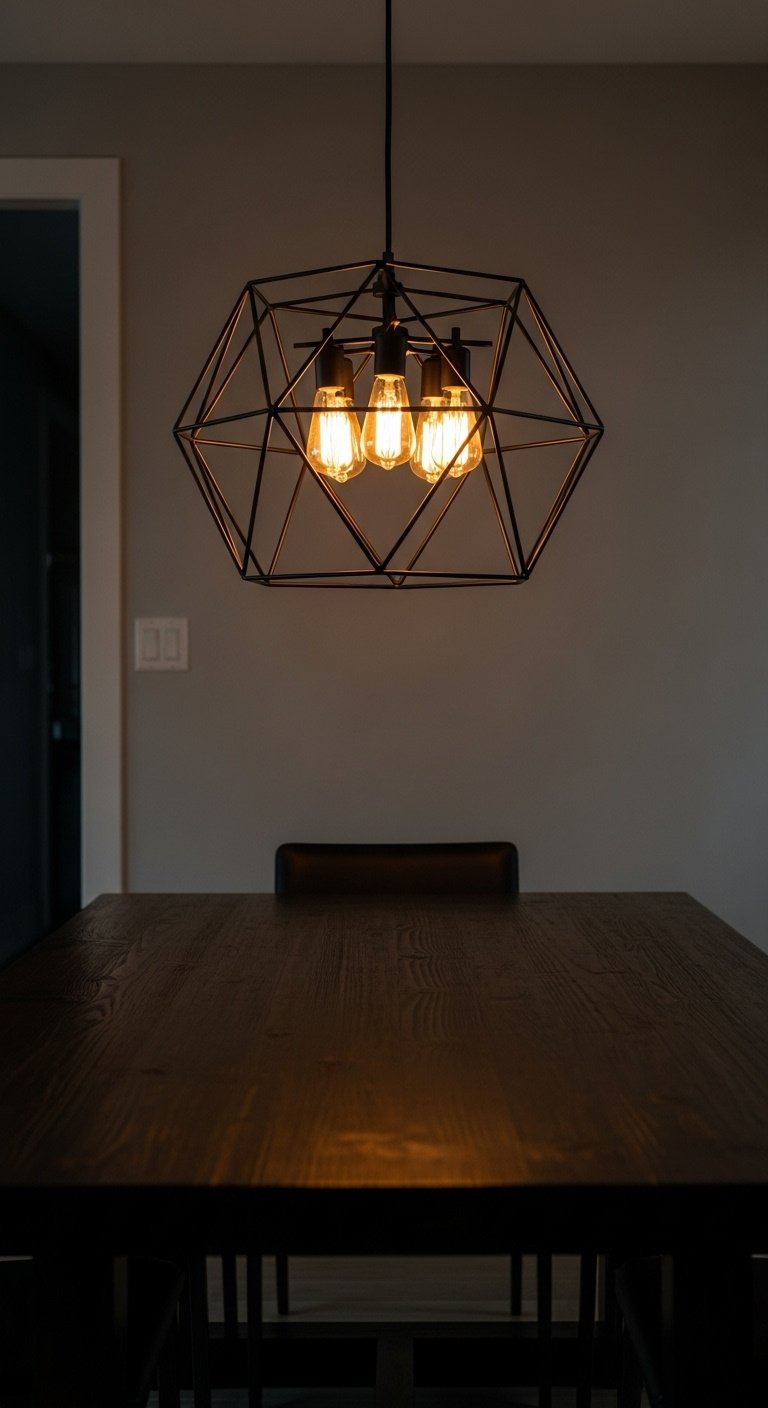
A table makeover isn’t just about the table itself; it’s about the entire dining area. Hanging a new, stylish light fixture over your table can completely change the ambiance and make your newly refinished table the star of the show.
- Materials Needed: New light fixture, ladder, basic electrical tools (wire stripper, voltage tester). Note: Consult an electrician if you are not comfortable with wiring.
- Step-by-Step Directions:
- Choose a Style: Select a light fixture that complements your table’s new look. Geometric or industrial pendants are great for modern styles, while a beaded chandelier works for a boho or coastal feel.
- Turn Off Power: Safety first! Turn off the power to the existing light fixture at the circuit breaker.
- Install Fixture: Remove the old fixture and install the new one according to the manufacturer’s instructions, connecting the wires correctly (black to black, white to white, ground to ground).
- Select Bulbs: Choose bulbs with the right light tone. Use bright white (3000K-4000K) for a modern, clean feel or warm white (2700K) for a cozier vibe.
- Restore Power: Turn the power back on at the breaker and test your new light.
Pro-Tip: The bottom of the light fixture should hang approximately 30-36 inches above the tabletop to provide adequate light without obstructing views across the table.
Light it up! Pin this dining room ambiance idea.
10. Bring Out Natural Beauty with a Simple Wood Oil Finish
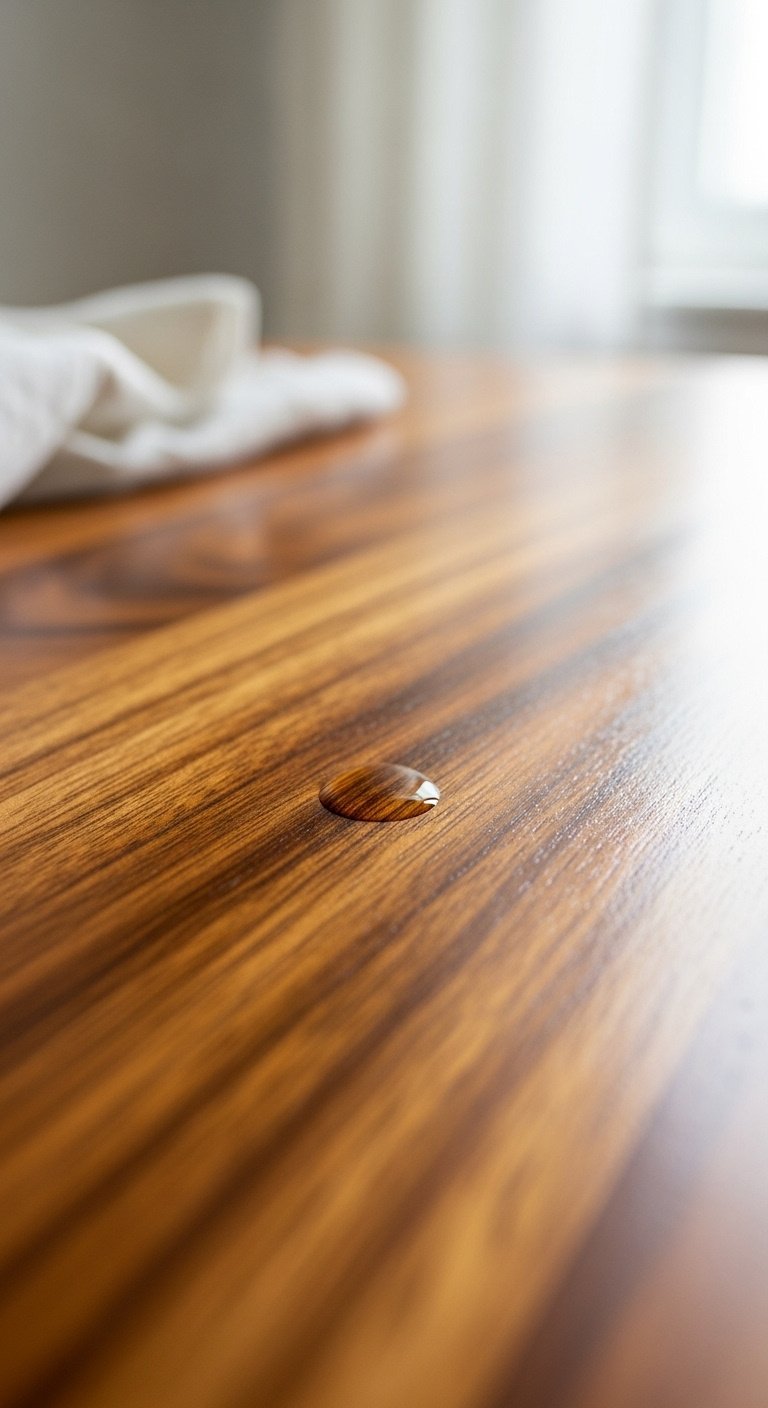
If you love the natural look of wood, a simple wood oil finish is the perfect way to enhance and protect the grain. After sanding the tabletop down to raw wood, an oil finish like Tung or Danish oil penetrates the wood to create a beautiful, natural, and gentle luster that’s easy to repair.
- Materials Needed: Fine-grit sandpaper (220 grit), wood oil (e.g., Tung oil, Danish oil), clean lint-free rags.
- Step-by-Step Directions:
- Prep: Ensure the tabletop is sanded completely smooth down to the raw wood and is free of any dust.
- Apply First Coat: Apply a generous amount of wood oil to the surface with a clean rag, rubbing it in the direction of the wood grain.
- Let it Penetrate: Allow the oil to soak into the wood for about 15-30 minutes, or as directed on the product label.
- Wipe Off Excess: Use a new, clean rag to wipe off all excess oil from the surface. The wood should not feel oily or wet to the touch.
- Repeat: Apply 2-4 more coats, waiting 24 hours between each coat, until you achieve your desired luster and protection.
Lesson Learned: It’s crucial to wipe off all the excess oil. Any oil left to dry on the surface will become a sticky, tacky mess that’s difficult to remove.
For the love of wood grain! Save this natural finish idea.
11. The Classic Two-Tone: Stain the Top, Paint the Base
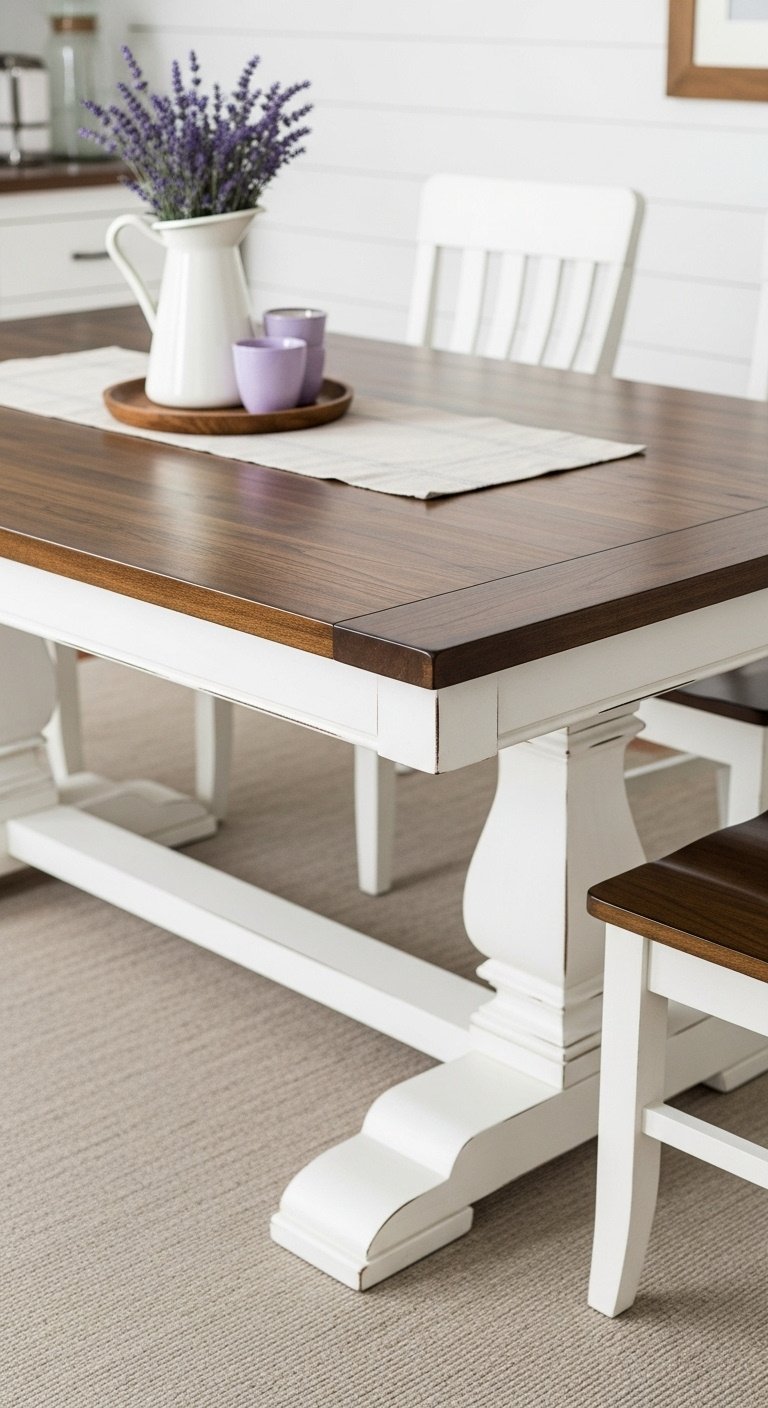
The most popular and timeless kitchen table makeover involves staining the tabletop to highlight the wood grain and painting the base for a clean, contrasting look. This classic two-tone finish is perfect for achieving a modern farmhouse or rustic style and completely transforms any old wooden table.
- Materials Needed: Chemical stripper or sander, sandpaper (80, 120, 220 grits), wood conditioner, stain, paint, primer, water-based polyurethane, brushes, rags.
- Step-by-Step Directions:
- Strip & Sand Top: Remove the old finish from the tabletop using a chemical stripper or by sanding it down to raw wood. Start with a coarse 80-grit sandpaper and work your way up to a smooth 220-grit finish.
- Condition & Stain Top: Apply a pre-stain wood conditioner to prevent blotchiness. Then, apply your chosen wood stain in thin, even coats with a rag until you reach the desired color.
- Prep & Paint Base: While the stained top dries, clean and lightly sand the table base and legs. Apply one coat of quality primer, followed by 2-3 coats of your paint color (chalk paint is a popular choice for easy adhesion).
- Seal for Protection: Once everything is fully dry, apply 3-5 coats of water-based polyurethane to the stained tabletop for maximum durability. Lightly sand with 320-grit paper between the final coats for an ultra-smooth finish.
Pro-Tip: Always use a water-based polyurethane over a water-based stain, and an oil-based poly over an oil-based stain. Mismatching can cause adhesion issues and yellowing over time.
Pin this timeless farmhouse table makeover tutorial!
Key Takeaways: Your Quick Guide to a Kitchen Table Makeover
Feeling ready to tackle your project? Keep these key points in mind for a successful and professional-looking result.
- Start with a Solid Foundation: Before any cosmetic work, make sure your table is structurally sound. Tighten and fix any wobbly legs first.
- Preparation is Everything: Do not skip the cleaning, sanding, and priming steps. Proper prep work is 90% of a professional-looking finish and ensures your hard work will last.
- Choose the Right Topcoat: For a high-traffic kitchen table, a durable sealer is non-negotiable. Water-based polyurethane is an excellent choice for its superior durability and non-yellowing properties.
- Budget Wisely: A full makeover can be done for under $120, but be sure to plan your material costs for stripper, sandpaper, paint, stain, and a quality sealer.
- Allow for Curing Time: Your project isn’t finished when the last coat is dry to the touch. Allow the finish to fully cure (this can take days or even weeks depending on the product) before heavy use to prevent scratches and dings.
People Also Ask About Kitchen Table Makeovers
How do I refurbish my kitchen table?
To refurbish a kitchen table, start by cleaning it thoroughly and removing the old finish with a sander or chemical stripper. Sand the surface smooth, then apply a pre-stain wood conditioner for an even finish. Next, apply your choice of stain or paint to the top and base. Finally, protect your work with 3-5 coats of a durable water-based polyurethane sealer for a long-lasting, professional result.
What is the best coating for a kitchen table?
The best coating for a kitchen table is a water-based polyurethane. It offers excellent durability against scratches, spills, and daily use. Unlike oil-based options, it dries clear, won’t yellow over time, has a lower odor, and allows for easier cleanup with just soap and water. For maximum protection, apply at least three to five coats, allowing each to dry completely.
How much does it cost to have a kitchen table refinished?
Professional dining table refinishing services typically cost between $400 and $700, depending on the table’s size, condition, and the desired finish. In contrast, a DIY kitchen table makeover is significantly more affordable, with material costs generally ranging from just $20 to $120 for sandpaper, stripper, paint, stain, and sealer, making it a very budget-friendly project.
Is it better to stain or paint a kitchen table?
The choice between staining and painting depends on your desired look and the table’s condition. Staining enhances the natural wood grain for a warm, classic feel, but it requires the wood to be in good condition. Painting can cover imperfections and offers endless color possibilities for a modern or custom look. A popular option is to do both: stain the top and paint the base for a stylish two-tone effect.
Final Thoughts
Your kitchen table is more than just furniture; it’s where memories are made. With these ideas, you can transform it from a piece you tolerate into a piece you truly love without breaking the bank. A little bit of creativity and effort can completely refresh your dining space and give you a custom table that’s perfectly suited to your home and style.
Which makeover idea are you most excited to try first? Share your plans in the comments below
